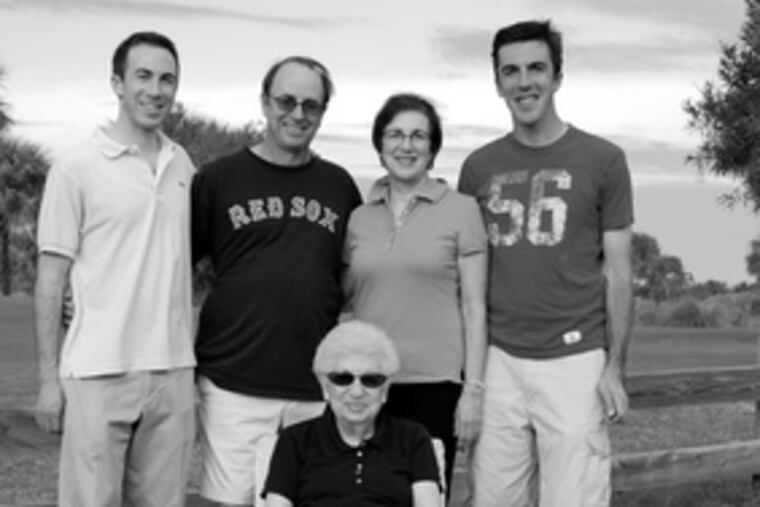
The Galleries at Moore have taken another step in the right direction with "In Repose," an exhibition of provocative, sometimes startlingly frank works dealing with sexuality, identity and sexual identity by contemporary women artists from the collection of Debra and Dennis Scholl. The title should not be taken too literally, by the way.
Restful
is about the last word I would apply to this show.
The Scholls' collection, or at least works culled from it that are on view in Moore's Goldie Paley Gallery, comprises primarily photographic images, largely staged, of women who appear troubled, exposed, caught in dicey situations, or all three. (The Scholls' reaction when told their collection suggested a theme, which they reveal in the catalog's foreword, is fascinating: "We were dumbfounded when one curator described a main thread of the collection as 'women in peril' - we had never considered that concept when acquiring works.")
One such photo could be Helen van Meene's late-'90s image of a pensive young woman nude to the waist, her forearms and lower torso encircled (bound?) by a lacy skirt. Another is Cindy Sherman's 1984 self-portrait as an aging barfly, a comic nightmare in Sherman's staging but a recognizably sad type nevertheless. Bettina von Zwehl's portraits of two disheveled young women isolated against white backdrops borrow from the mug shot.
Pipilotti Rist, in her 1986 speeded-up music video of herself, "I'm Not the Girl Who Misses Much," in which she performs frantically in a breast-exposing dress, could pass for Britney. Performance artist Carolee Schneemann's campy 1963 nude photo of herself, snakes slithering across her torso, reminds us how the art world has changed; the works by younger artists in this show do not even seem to anticipate the male gaze, let alone react to it.
Only a few works in "In Repose" bring that term to mind (it's the original Latin meaning of
repose
, to pause or stop, that resonates throughout this exhibition). They include Tanyth Berkeley's 2006 photograph of a corpulent young woman sitting with her back to a window, an ecstatic expression on her face; Trisha Donnelly's quietly self-possessed installation of a white pine bough mounted horizontally below a door lintel, bay leaves hanging vertically from the bough to form a T (for Trisha); Katy Grannan's 2002 photograph of a nude woman on a blanket in the woods, a lake shimmering behind her, and Catherine Opie's photograph of her own exposed back, pricked with a needle to make a childlike drawing in blood - a house, a large cloud, and two mommies holding hands.
I was surprised that a concurrent Moore exhibition, "Encapsulated Time: Age, Image and Rock 'n Roll," in its Levy Gallery for the Arts in Philadelphia, features only two artists, both working in photography and video. The theme could be fleshed out through various media, especially certain kinds of painting and sculpture that are themselves physical embodiments of encapsulated time.
But this show takes a more documentary approach to time. The work of Philadelphia-based Judy Gelles and Andrew Suggs is very much about the people who inhabit their images and their own human perceptions of time.
In his works, Suggs mostly hovers in the background. But Gelles, in her extended project documenting visits to her parents in Florida with her husband and two sons between 1982 and 2007, is a constant in these family portraits, shot with her camera on a timer and a tripod. Her voice is present, too, as in a framed statement - mounted between a family portrait including her father and subsequent ones without him - in which she explains that he died of colon cancer he had kept secret from his family.
Gelles' video,
Artists on Age
(2007), is the more transcendent work. Her interviews with artists, composers, architects and writers ages 20 to 80, showing only her subjects' faces from the tips of their noses to their chins, and asking each what it is like to be the age he or she is, are entirely absorbing in their plainness and honesty. You think, immediately, that you have thought these thoughts and rarely voiced them.
Suggs is showing digitally altered photographs of crowd scenes at concerts, divided into mirror images at their centers. These are modest, handsome pieces, horizontal inkjet prints mounted to Plexiglas. But, as with Gelles' family project, Suggs' photos are less interesting than his videos, shown on six TVs, in which young people listen to 1970s songs on headphones and try to sing them. I was not initially taken with this, lacking the patience to watch Suggs' subjects get into their individual grooves. But when I returned, I was fascinated to hear their uniformly awkward, tentative versions of songs I once knew well, and to remember that I knew pop music before my time better than these amateurs seem to.
In other words, I recognized, and appreciated, my own youth - time, encapsulated.